
Lasius is a genus of formicine ants. The type species for this genus is the black garden ant, Lasius niger. Other major members, which live in drier heathland, are the cornfield ant, L. neoniger, and L. alienus. Other species include the temporary social parasites of the L. mixtus group and the hyper-social parasite Lasius fuliginosus. Lasius flavus is also a commonly seen species, building grassy hillocks in undisturbed pasture. In the Alps, these mounds - always aligned east to catch the first rays of the rising sun - have been traditionally used by goatherds as natural compasses. Species in the subgenus Acanthomyops, in particular L. interjectus and L. claviger, are commonly known as citronella ants due to their citronella-like smell.
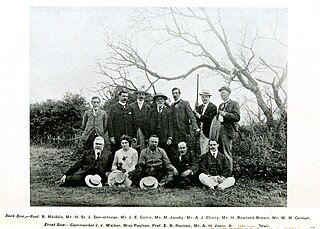
Horace St. John Kelly Donisthorpe was an eccentric British myrmecologist and coleopterist, memorable in part for his enthusiastic championing of the renaming of the genus Lasius after him as Donisthorpea, and for his many claims of discovering new species of beetles and ants. He is often considered to be the greatest figure in British myrmecology.
Lasius murphyi is a species of ant in the genus Lasius. It is endemic to the United States and Canada.

Lasius fuliginosus, also known as the jet ant or jet black ant, is a species of ant in the subfamily Formicinae.

Claviger is a genus of beetles in the family Staphylinidae, subfamily Pselaphinae. About 40 species and subspecies are described, divided into two subgenera, Claviger (Claviger) and Claviger Clavifer. Claviger displays unusual biological adaptations to myrmecophily. This pselaphid is of palearctic distribution.

Lasius arizonicus is a species of ant belonging to the genus Lasius, formerly a part of the genus Acanthomyops. Described in 1917 by Wheeler, the species is native to the United States.
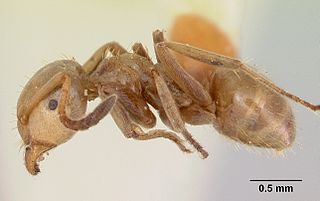
Lasius bureni is a species of ant belonging to the genus Lasius, formerly a part of the subgenus Acanthomyops. Described in 1968 by Wing, the species is native to the United States.

Lasius californicus is a species of ant belonging to the genus Lasius, and was formerly a part of the genus Acanthomyops. Described in 1917 by Wheeler, the species is native to the United States.
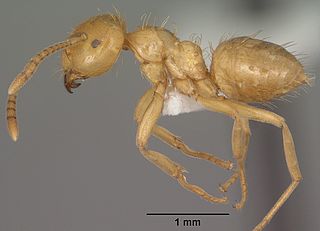
Lasius colei is a species of ant belonging to the genus Lasius, formerly a part of the genus Acanthomyops. Described in 1968 by Wing, the species is native to the United States.
Lasius coloradensis is a species of ant belonging to the genus Lasius, formerly a part of the genus Acanthomyops. Described in 1917 by Wheeler, the species is native to the United States. The queens of will make a claustral chamber and hibernate, laying eggs in the spring.

Lasius creightoni is a species of ant belonging to the genus Lasius, formerly a part of the genus Acanthomyops. Described in 1968 by Wing, the species is native to the United States.
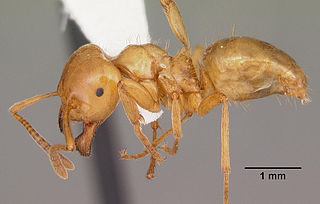
Lasius interjectus, commonly known as the larger yellow ant, is a species of ant belonging to the genus Lasius, and was formerly a part of the genus Acanthomyops. Described in 1866 by Mayr, the species is native to the United States.
Lasius mexicanus is a species of ant belonging to the genus Lasius, formerly a part of the genus Acanthomyops. Described in 1914 by William Morton Wheeler, the species is native to Mexico.

Lasius occidentalis is a species of ant belonging to the genus Lasius, formerly a part of the genus Acanthomyops. Described in 1909 by Wheeler, the species is native to the United States.

Lasius plumopilosus is a species of ant belonging to the genus Lasius, formerly a part of the genus Acanthomyops. Described in 1941 by Buren, the species is native to the United States, notably from the state of Iowa.

Lasius pogonogynus is a species of ant belonging to the genus Lasius, formerly part of the genus Acanthomyops. Described in 1950 by Buren, the species is native to the United States.
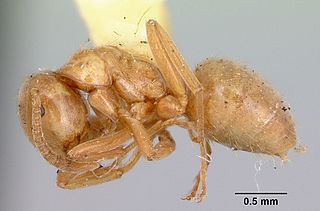
Lasius pubescens is a species of ant belonging to the genus Lasius, formerly a part of the genus Acanthomyops. Described in 1942 by Buren, the species is native to the United States.
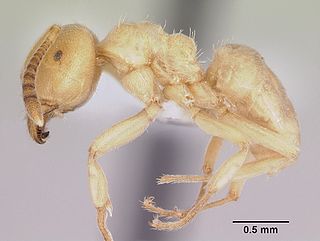
Lasius subglaber is a species of ant belonging to the genus Lasius, formerly a part of the genus Acanthomyops. Described in 1893 by Emery, the species is native to the United States and Canada.

Many species of Staphylinidae have developed complex interspecies relationships with ants, known as myrmecophily. Rove beetles are among the most rich and diverse families of myrmecophilous beetles, with a wide variety of relationships with ants. Ant associations range from near free-living species which prey only on ants, to obligate inquilines of ants, which exhibit extreme morphological and chemical adaptations to the harsh environments of ant nests. Some species are fully integrated into the host colony, and are cleaned and fed by ants. Many of these, including species in tribe Clavigerini, are myrmecophagous, placating their hosts with glandular secretions while eating the brood.















